WOW
SLOW TRAVEL
52 CITIES
1 WEEK
EACH CITY
52 WEEKS
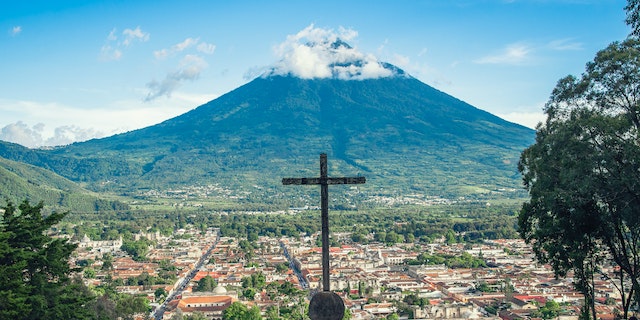
Guatemala
Guatemala, officially known as the Republic of Guatemala, is a captivating and diverse country located in Central America. It is bordered by Mexico to the north and west, Belize to the northeast, Honduras to the east, and El Salvador to the southeast. Guatemala is often referred to as the “Land of Eternal Spring” due to its pleasant climate, which makes it a popular destination for travelers seeking natural beauty, rich culture, and historical significance.
Here are some key aspects of Guatemala:
Geography and Landscape: Guatemala’s landscape is characterized by dramatic diversity. It boasts soaring volcanic peaks, lush rainforests, expansive highland plateaus, and pristine lakes. The country’s most iconic volcano is Pacaya, which frequently emits smoke and ash, providing a striking backdrop to the capital city, Guatemala City.
Culture and Heritage: Guatemala has a rich cultural heritage that is a blend of indigenous Mayan traditions, Spanish colonial influence, and modern influences. The country is home to over 20 indigenous Mayan groups, each with its own distinct language and traditions. The vibrant culture is evident in the colorful clothing, traditional music, and unique artistry of its people.
Mayan Ruins: Guatemala is home to some of the most impressive Mayan archaeological sites in the world. Tikal, located in the northern Petén region, is one of the most famous and boasts ancient temples and pyramids that rise above the dense jungle canopy. Other notable sites include Quiriguá, Copán (in neighboring Honduras), and Iximché.
Colonial Architecture: Antigua Guatemala, a UNESCO World Heritage site, is a well-preserved colonial town that showcases the country’s Spanish heritage. Its cobbled streets, pastel-colored buildings, and Baroque-style churches are a testament to its colonial past.
Biodiversity: Guatemala’s diverse ecosystems support an incredible array of flora and fauna. The country is home to jaguars, quetzals (the national bird), howler monkeys, and numerous bird species. Lake Atitlán, surrounded by volcanoes, is one of the most picturesque and ecologically significant areas in Central America.
Cuisine: Guatemalan cuisine is a reflection of its multicultural heritage. Traditional dishes include tamales, pepián (a spicy stew), and chiles rellenos. Street food, such as tacos and pupusas, is also popular, offering a flavorful experience for food enthusiasts.
Challenges: While Guatemala has immense natural and cultural wealth, it also faces significant challenges. Poverty, inequality, and issues related to political stability and corruption have been persistent challenges for the nation.
Tourism: Despite its challenges, tourism is a growing industry in Guatemala. Visitors come to explore the country’s natural beauty, ancient ruins, and unique cultural experiences. Activities such as hiking, birdwatching, and exploring the local markets are popular among tourists.
Languages: Spanish is the official language of Guatemala, but there are also over 20 indigenous languages spoken throughout the country, with K’iche’ and Q’eqchi’ being among the most widely spoken indigenous languages.
Guatemala’s mix of natural wonders, cultural diversity, and historical significance makes it a fascinating and enchanting destination for travelers looking to immerse themselves in the beauty and authenticity of Central America. Whether you’re exploring ancient ruins or savoring traditional cuisine, Guatemala offers a rich and unforgettable experience
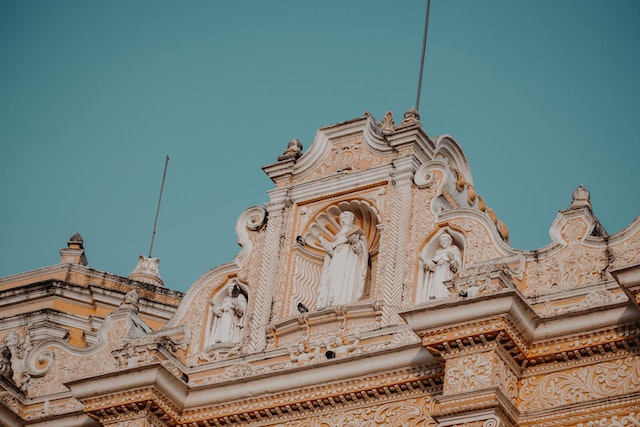
Antigua Guatemala
Antigua Guatemala, often referred to simply as “Antigua,” is a historic and charming city nestled in the central highlands of Guatemala. This UNESCO World Heritage-listed city is renowned for its exceptionally well-preserved Spanish Baroque-influenced architecture, cobblestone streets, and a vibrant cultural scene. It is one of the most popular and picturesque destinations in Central America, attracting tourists and expatriates alike.
Here are some key aspects of Antigua Guatemala:
Historical Significance: Antigua was the former capital of Guatemala and played a crucial role during the Spanish colonial era. Founded in the early 16th century, it served as the capital of the Captaincy General of Guatemala, which encompassed much of Central America. The city was known for its grand churches, monasteries, and government buildings.
Colonial Architecture: One of Antigua’s most striking features is its well-preserved colonial architecture. Visitors can explore historic churches and convents, including the iconic Santa Catalina Arch, which dates back to the 17th century. The city’s colorful facades and ornate courtyards provide a captivating glimpse into its colonial past.
Cobblestone Streets: Antigua’s narrow, cobblestone streets are a defining characteristic of the city’s old-world charm. Strolling through these streets, lined with colonial buildings, offers a unique and picturesque experience. The central park, Parque Central, is a focal point for both locals and tourists and features a lovely garden and a central fountain.
Culture and Arts: Antigua has a vibrant cultural scene with art galleries, museums, and a thriving community of artists and artisans. It hosts various cultural events and festivals throughout the year, including Holy Week (Semana Santa), when elaborate processions fill the streets.
Language Schools: Antigua is a popular destination for individuals wanting to learn Spanish. The city is home to numerous language schools that offer immersive language programs for students of all levels. The combination of rich culture and language learning opportunities makes Antigua an ideal place to study.
Cuisine: The city’s culinary scene offers a fusion of traditional Guatemalan and international flavors. You can savor local dishes like pepián (a spicy stew), tamales, and street food such as elotes (corn on the cob) and chuchitos (steamed dumplings).
Natural Beauty: Nestled among three volcanoes—Agua, Fuego, and Acatenango—Antigua boasts stunning natural surroundings. Hiking enthusiasts can embark on treks up these volcanoes for breathtaking views of the city and surrounding landscapes.
Retirement and Expatriate Community: Antigua is a popular choice for retirees and expatriates due to its pleasant climate, safety, and the availability of amenities catering to an international community. It offers a serene and peaceful environment for those looking to enjoy their retirement years.
Accessibility: The city is well-connected to Guatemala City, located just 25 miles (40 kilometers) away, making it easily accessible for both domestic and international travelers.
While Antigua Guatemala has preserved its colonial charm, it has also evolved into a vibrant and cosmopolitan city, catering to tourists, language learners, and retirees alike. Its unique blend of history, culture, and natural beauty makes it a captivating destination that continues to enchant visitors from around the world
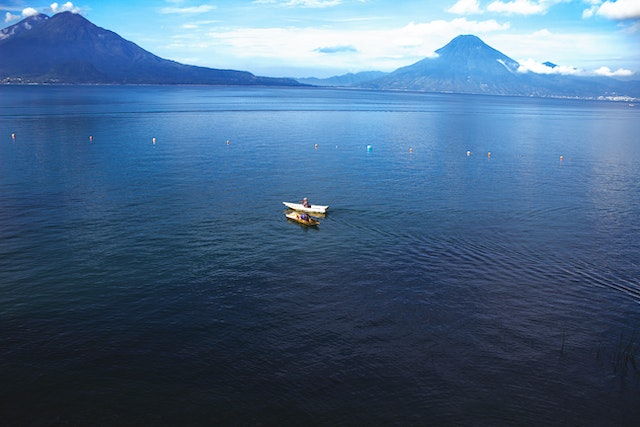
Lake Atitlán
Lake Atitlán is a stunning natural gem located in the highlands of Guatemala. Nestled within a volcanic crater and surrounded by towering peaks, this picturesque lake is often considered one of the most beautiful in the world. Lake Atitlán is a popular destination for travelers seeking tranquility, natural beauty, and cultural immersion.
Here are some key features and highlights of Lake Atitlán:
Natural Beauty: The lake is renowned for its breathtaking natural beauty. Surrounded by three towering volcanoes—San Pedro, Atitlán, and Tolimán—Lake Atitlán’s crystal-clear waters reflect the ever-changing colors of the sky and surrounding landscapes. The scenic beauty of the lake and its dramatic setting in the highlands make it a paradise for nature enthusiasts and photographers.
Indigenous Culture: The shores of Lake Atitlán are dotted with indigenous Mayan villages, each with its own unique culture and traditions. Villages like Panajachel, San Pedro La Laguna, Santiago Atitlán, and San Marcos La Laguna offer a glimpse into the rich Mayan heritage of the region. Visitors can explore local markets, interact with artisans, and witness traditional ceremonies.
Adventure and Outdoor Activities: The area around Lake Atitlán is a haven for outdoor enthusiasts. Hiking and trekking opportunities abound, with trails leading to the summits of the surrounding volcanoes. Water sports like kayaking, paddleboarding, and swimming are popular, and the lake’s calm waters make it ideal for these activities. Birdwatching and zip-lining are also available for those seeking adventure.
Relaxation and Wellness: Lake Atitlán has attracted spiritual seekers and wellness enthusiasts from around the world. Numerous yoga retreats, meditation centers, and holistic healing practices are available in the lakeside villages. The serene environment, fresh mountain air, and stunning scenery create an ideal setting for relaxation and rejuvenation.
Sustainable Tourism: Lake Atitlán has been a focal point for sustainable tourism initiatives. Efforts to protect the lake’s fragile ecosystem and support local communities have gained momentum. Travelers can participate in eco-friendly activities, stay in eco-lodges, and purchase handmade crafts from local artisans, contributing to the region’s sustainable development.
Boat Tours: Exploring the lake by boat is a popular activity. Small motorboats and traditional wooden canoes, known as “lanchas,” provide transportation between villages. These boat rides offer a unique perspective of the lake’s beauty and the daily life of the indigenous communities.
Cuisine: Visitors to Lake Atitlán can savor traditional Guatemalan dishes and international cuisine at the lakeside restaurants. Fresh fish from the lake is a local delicacy, often served with a variety of flavorful sauces.
Cultural Festivals: Throughout the year, Lake Atitlán hosts various cultural festivals and celebrations. One of the most famous is the Santiago Atitlán Fiesta, which honors the patron saint of the village and features traditional music, dances, and processions.
Lake Atitlán is not only a natural wonder but also a cultural and spiritual haven. Its captivating blend of natural beauty, indigenous traditions, and outdoor activities make it a must-visit destination for travelers seeking a unique and enriching experience in Guatemala. Whether you’re looking for adventure, relaxation, or cultural immersion, Lake Atitlán has something to offer everyone
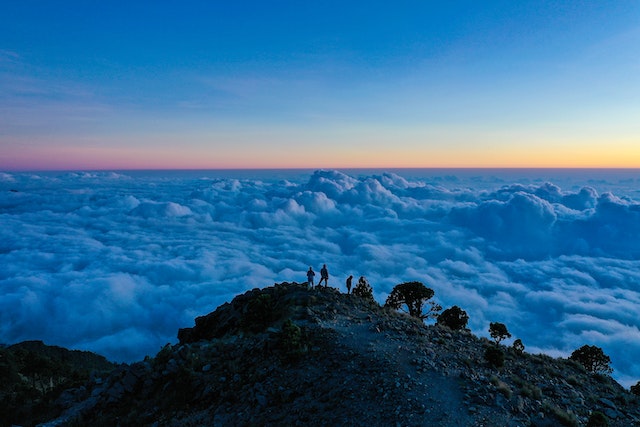
Quetzaltenango(Xela)
Quetzaltenango, commonly referred to as Xela (pronounced “sheh-lah”), is the second-largest city in Guatemala and a vibrant cultural and historical hub in the country’s western highlands. Nestled in a picturesque valley surrounded by lush mountains and active volcanoes, Xela offers a unique blend of indigenous traditions, colonial architecture, and a modern urban lifestyle. Here’s a closer look at this fascinating Guatemalan city:
Historical Significance: Quetzaltenango has a rich history dating back to pre-Columbian times when it was inhabited by indigenous Maya people. During the Spanish colonial period, it became a prominent regional center. Its historical significance is reflected in its well-preserved colonial architecture, including churches, government buildings, and private residences.
Cultural Diversity: Xela is known for its cultural diversity and is home to various indigenous communities, including K’iche’, Mam, and Q’eqchi’. This cultural mix is evident in the city’s vibrant markets, where you can find traditional textiles, handicrafts, and local cuisine.
Language Schools: Xela is one of Guatemala’s premier destinations for learning Spanish. The city is home to numerous language schools that offer immersion programs for students of all levels. Many travelers come to Xela to improve their language skills while experiencing Guatemalan culture firsthand.
Central Park (Parque Central): The heart of Xela is its central park, a lively gathering place surrounded by colonial-era buildings, cafes, and shops. It’s a great spot to relax, people-watch, and enjoy the local ambiance.
Natural Beauty: The city is surrounded by natural beauty, including nearby volcanoes such as Santa María, Santiaguito, and Chicabal. These volcanoes offer hiking and trekking opportunities with rewarding vistas of the city and surrounding landscapes.
Cultural Festivals: Xela hosts a variety of cultural festivals and events throughout the year. One of the most significant is the Feria de Independencia, celebrating Guatemala’s independence from Spain. During this time, the city comes alive with parades, music, dancing, and food.
Local Cuisine: Xela offers a diverse culinary scene, with traditional Guatemalan dishes and international cuisine. Be sure to try local specialties like tamales, chuchitos (steamed dumplings), and the regional dish called “kak’ik,” a turkey soup with spices.
Community Engagement: Xela provides opportunities for travelers to engage with local communities through volunteering and cultural exchange programs. These initiatives allow visitors to contribute to local development while gaining a deeper understanding of Guatemalan life.
Geothermal Hot Springs: In the nearby town of Fuentes Georginas, you can soak in geothermal hot springs surrounded by lush rainforest. It’s a perfect way to relax and unwind after a day of exploring the region.
Accessibility: Quetzaltenango is easily accessible from Guatemala City by bus or private transportation. The city also serves as a gateway to other popular destinations in the western highlands, including Lake Atitlán and the market town of Chichicastenango.
Quetzaltenango, or Xela, is a city that combines history, culture, natural beauty, and educational opportunities. Whether you’re interested in language learning, hiking in the mountains, or immersing yourself in Guatemalan culture, Xela has something to offer every traveler seeking an authentic and enriching experience in Guatemala
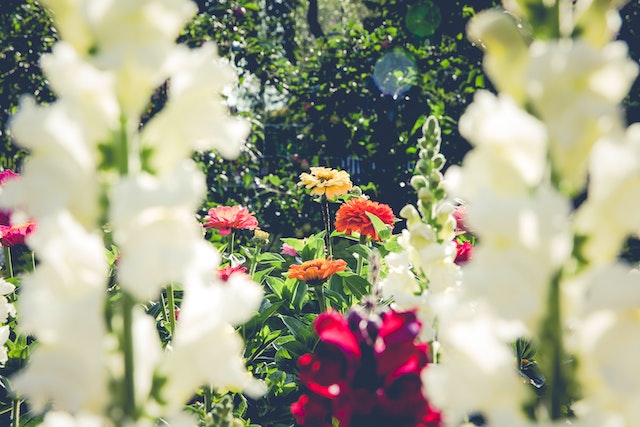
Flores
Flores is a charming island town located in the northern part of Guatemala, nestled on Lake Petén Itzá. This picturesque town is known for its scenic beauty, colonial architecture, and its role as a gateway to some of the country’s most famous archaeological sites, including the ancient Mayan city of Tikal. Here’s a closer look at Flores, Guatemala:
Island Location: Flores is situated on an island in the middle of Lake Petén Itzá, connected to the mainland by a causeway. Its unique island setting gives it a tranquil and almost fairy-tale-like atmosphere, with colorful buildings lining its narrow streets and waterfront.
Gateway to Tikal: Flores is often used as a base for exploring Tikal, one of the most significant Mayan archaeological sites in the world. Tikal, a UNESCO World Heritage site, is located in the nearby Tikal National Park and is renowned for its towering pyramids, temples, and well-preserved ruins. Flores is the closest urban center to Tikal, making it a convenient starting point for day trips to the ancient city.
Historic Charm: The town of Flores itself is rich in history and colonial architecture. The cobblestone streets, colonial-era churches, and colorful buildings provide a delightful backdrop for exploring. The central square, known as Parque Central, is a hub of activity with restaurants, shops, and a pleasant place to relax.
Local Cuisine: Flores offers a variety of dining options, ranging from local Guatemalan cuisine to international dishes. You can sample traditional Guatemalan fare such as pepián (a spicy stew), tamales, and street food like tacos and pupusas.
Lakeside Activities: Given its location on Lake Petén Itzá, Flores offers opportunities for water-based activities. You can rent boats for tours around the lake, go fishing, or simply enjoy the serene lakeside views.
Sunsets: Flores is famous for its stunning sunsets over Lake Petén Itzá. Many visitors and locals gather along the lakeshore or on the causeway to witness the breathtaking spectacle as the sun dips below the horizon.
Wildlife and Nature: The region around Flores is teeming with wildlife, including various bird species and howler monkeys. Nature enthusiasts can explore nearby protected areas like Yaxhá-Nakum-Naranjo National Park, which is home to more archaeological sites and rich biodiversity.
Access and Accommodation: Flores is easily accessible by road, making it a popular stop for travelers exploring northern Guatemala. It offers a range of accommodations, from budget-friendly hostels to boutique hotels and resorts.
Cultural Events: Flores hosts various cultural events and festivals throughout the year, celebrating local traditions and holidays. These events often include music, dance, and vibrant parades.
Relaxed Atmosphere: One of the most appealing aspects of Flores is its laid-back and relaxed atmosphere. It’s a place where you can unwind, enjoy the natural beauty, and experience the warmth and friendliness of the local people.
Flores, Guatemala, is more than just a convenient base for exploring Tikal; it’s a destination in its own right. Whether you’re interested in history, nature, or simply seeking a tranquil lakeside retreat, Flores has much to offer travelers looking to experience the charm and culture of northern Guatemala
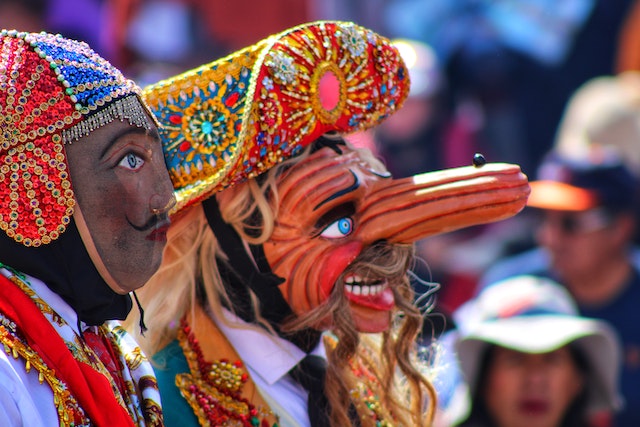
Cobán
Cobán is a picturesque city situated in the heart of the Alta Verapaz region in Guatemala. Known for its lush landscapes, indigenous culture, and pleasant climate, Cobán offers a unique and off-the-beaten-path experience for travelers looking to explore a lesser-known part of the country. Here’s a closer look at Cobán, Guatemala:
Natural Beauty: Cobán is surrounded by breathtaking natural beauty. The city is nestled in the mountains, surrounded by cloud forests and dense rainforests. The region is known for its waterfalls, caves, and abundant greenery, making it a haven for nature enthusiasts and adventurers.
Caves and Caverns: The Alta Verapaz region is home to numerous caves and caverns waiting to be explored. Some of the most famous include Semuc Champey, known for its turquoise pools, and Lanquin Caves, which are filled with impressive stalactites and stalagmites.
Mild Climate: Cobán boasts a temperate and mild climate due to its elevation, earning it the nickname “The City of Eternal Spring.” This comfortable climate is a welcome escape from the heat of the lowland areas.
Indigenous Culture: Cobán and the surrounding region are inhabited by various indigenous communities, including Q’eqchi’ and Poqomchi’. Travelers have the opportunity to engage with these indigenous groups, learn about their traditions, and purchase local handicrafts and textiles.
Coffee Production: The Alta Verapaz region is known for its coffee production. Coffee enthusiasts can visit coffee farms to learn about the coffee-making process and sample some of the finest Guatemalan coffee beans.
Orchids and Botanical Gardens: Cobán is famous for its orchids, and there are botanical gardens dedicated to these stunning flowers. The Vivero Verapaz orchid farm is a must-visit for anyone interested in the world of orchids.
Festivals: The city hosts various cultural festivals throughout the year, with the most famous being the Cobán Fair (Feria de Cobán). During this event, the city comes alive with parades, live music, and traditional dances.
Adventure Activities: The surrounding natural beauty of Cobán offers opportunities for adventure activities such as hiking, birdwatching, and river rafting. Local tour operators provide guided excursions to explore the region’s pristine landscapes.
Local Cuisine: Cobán offers a taste of traditional Guatemalan cuisine, with local specialties like pepián (a spicy stew), tamales, and chuchitos (steamed dumplings) readily available. The local markets are excellent places to sample authentic dishes.
Relaxed Atmosphere: Cobán has a laid-back and relaxed atmosphere, making it an ideal destination for those looking to escape the hustle and bustle of more touristy areas. The friendly locals contribute to the city’s welcoming ambiance.
Cobán, Guatemala, is a hidden gem that offers a blend of natural beauty, cultural richness, and outdoor adventures. It’s a place where travelers can immerse themselves in indigenous culture, explore pristine landscapes, and enjoy a tranquil atmosphere away from the crowds. Whether you’re seeking relaxation or adventure, Cobán has much to offer for those looking to discover the hidden treasures of Guatemala
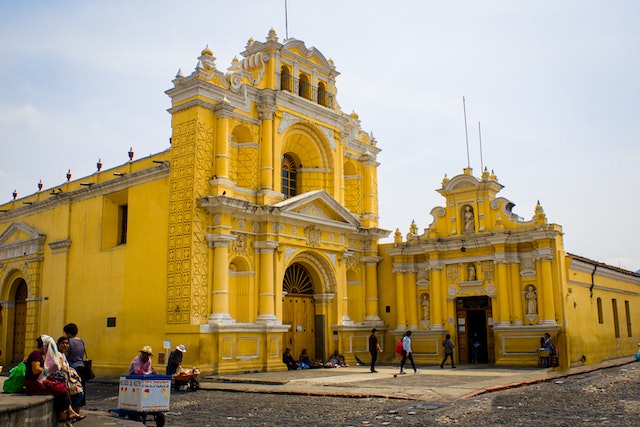
Guatemala City
Guatemala City, the capital of Guatemala, is a bustling metropolis that serves as the economic, political, and cultural hub of the country. Within this sprawling city, Zona 10 stands out as one of its most affluent and modern districts. Here’s a closer look at Guatemala City’s Zona 10:
Central Location: Zona 10, also known as “Zone 10” or “Zona Viva” (the living zone), is situated in the heart of Guatemala City. It is strategically located near the city’s major business districts, government offices, and cultural attractions.
Commercial and Business Center: Zona 10 is the primary business district of Guatemala City, housing numerous corporate offices, multinational companies, banks, and financial institutions. This concentration of commerce has made it a significant driver of the country’s economy.
Luxury Hotels and Accommodations: The district boasts some of the city’s most upscale and luxury hotels, making it a popular choice for business travelers and tourists seeking high-end accommodations. These hotels often feature world-class amenities, fine dining options, and stunning city views.
Shopping and Entertainment: Zona 10 offers an array of shopping centers and malls, including the prominent Oakland Mall and Pradera Concepción. These malls are home to international brands, designer boutiques, cinemas, and a diverse selection of restaurants and cafes.
Dining and Gastronomy: The district is known for its diverse culinary scene, offering an extensive range of dining options, from local Guatemalan cuisine to international dishes. You can find upscale restaurants, trendy cafes, and vibrant nightlife venues in Zona 10.
Culture and Arts: Zona 10 is home to several cultural institutions, including art galleries and theaters. The National Theater of Guatemala (Teatro Nacional) is located here, hosting a variety of cultural performances and events.
Safety and Security: Zona 10 is generally considered one of the safer neighborhoods in Guatemala City. Private security personnel and a strong police presence contribute to a sense of safety within the district.
Transportation Hub: The district is well-connected to other parts of the city and the country, with access to major roadways and transportation hubs. The La Aurora International Airport, the country’s largest airport, is located nearby.
Parks and Green Spaces: Despite its urban setting, Zona 10 features a few green spaces where residents and visitors can relax. The popular Roosevelt Park (Parque Roosevelt) offers a pleasant place to take a stroll or enjoy outdoor activities.
Residential Living: While primarily a business and commercial district, Zona 10 also offers residential options, with modern apartments and condominiums available for those who prefer to live in the heart of the city.
Zona 10 is a dynamic and vibrant district within Guatemala City, offering a blend of business, luxury, culture, and entertainment. It reflects the city’s growing economy and its increasing prominence on the global stage. Whether you’re visiting for business or leisure, Zona 10 provides a modern and cosmopolitan experience in the heart of Guatemala’s capital
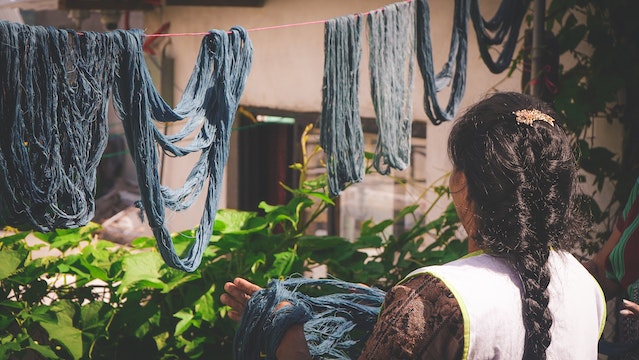
Retalhuleu
Retalhuleu is a charming town located in the southwestern region of Guatemala. Situated within the department of Retalhuleu, this town is known for its warm climate, agricultural activities, and its proximity to various attractions, including amusement parks and natural wonders. Here’s a closer look at Retalhuleu, Guatemala:
Agriculture: Retalhuleu is primarily an agricultural town, with its economy heavily reliant on activities such as coffee cultivation, sugar cane farming, and tropical fruit production. The fertile soil and warm climate make it an ideal location for these agricultural endeavors.
Climate: The town’s location in the southwestern lowlands of Guatemala gives it a hot and humid tropical climate. It’s known for experiencing warm temperatures throughout the year, which is typical for this region of the country.
Amusement Parks: One of the major draws for visitors to Retalhuleu is the presence of several amusement parks and entertainment centers. Among these, Xetulul and Xocomil stand out. Xetulul is a theme park with various themed zones and attractions, while Xocomil is a water park featuring numerous pools and water slides.
Natural Beauty: The surrounding region of Retalhuleu offers opportunities to explore Guatemala’s natural beauty. Nearby, you’ll find lush rainforests, rivers, and verdant landscapes. These natural areas provide opportunities for outdoor activities such as hiking and birdwatching.
Cultural Festivals: Retalhuleu, like many Guatemalan towns, celebrates various cultural festivals and religious events throughout the year. These festivities often include parades, traditional dances, and other cultural performances.
Local Cuisine: The town offers a taste of Guatemalan cuisine, with local specialties such as tamales, chuchitos (steamed dumplings), and atol (a hot corn-based drink). Visitors can also sample fresh tropical fruits from local markets.
Hospitality and Accommodations: While not as tourist-oriented as some other Guatemalan destinations, Retalhuleu does have a few hotels and accommodations to cater to travelers. These provide comfortable lodging options for visitors exploring the region.
Accessibility: Retalhuleu is easily accessible by road, making it a convenient stop for travelers exploring western Guatemala. It’s approximately a 3-4 hour drive from the capital, Guatemala City.
Sugar Cane Industry: The town is known for its sugar cane industry, which plays a significant role in the local economy. The sugar mills in the region produce a substantial portion of Guatemala’s sugar.
Local Markets: Retalhuleu features local markets where you can purchase fresh produce, handicrafts, and traditional goods. These markets offer an authentic glimpse into the daily life and culture of the town.
Retalhuleu, Guatemala, is a lesser-known destination that provides a unique blend of agriculture, entertainment, and natural beauty. While it may not be as well-known as some of the country’s more famous tourist spots, it offers a different perspective on Guatemalan life and culture and is worth exploring for those seeking a less-traveled path in this diverse Central American nation
Guatemala offers a range of cities and regions that can be appealing for Americans looking to retire in a more affordable and culturally rich environment. When considering retirement destinations in Guatemala, it’s important to take into account factors such as climate, cost of living, safety, healthcare, and proximity to amenities. Here are some of the best cities and areas for American retirees in Guatemala:
Antigua Guatemala: This UNESCO World Heritage-listed city is a popular choice for retirees due to its well-preserved colonial architecture, mild climate, and vibrant cultural scene. Antigua offers a range of amenities, including restaurants, shops, and healthcare facilities. It’s a favorite destination for expatriates, which means you’ll find a supportive community of fellow retirees.
Lake Atitlán: Located in the highlands of Guatemala, Lake Atitlán and its surrounding villages offer a tranquil and picturesque retirement setting. The lake is surrounded by volcanoes and lush landscapes, making it a paradise for nature lovers. Popular lakeside villages for retirees include Panajachel, San Pedro La Laguna, and Santa Cruz La Laguna.
Quetzaltenango (Xela): Xela, as it’s commonly known, is Guatemala’s second-largest city and offers a more authentic Guatemalan experience compared to Antigua. It has a pleasant climate, a lower cost of living, and a thriving local culture. Xela also has several language schools, making it an excellent place for retirees interested in learning Spanish.
Flores: If you prefer a more relaxed pace of life, Flores is a small island town in the Petén region. It’s known for its proximity to the Tikal archaeological site, which is a major attraction in Guatemala. Retirees can enjoy a tranquil lakeside environment and easy access to the country’s rich history and wildlife.
Cobán: Cobán, located in the Alta Verapaz region, is a city surrounded by lush rainforests and waterfalls. It offers a quieter and less touristy environment than some of the more popular destinations. The climate is temperate, and the cost of living is generally lower compared to major cities.
Guatemala City (Zona 10): While the capital city may not be the first choice for retirees due to its size and traffic, some areas, such as Zone 10 (Zona 10), offer a more upscale and modern living environment. It has shopping centers, restaurants, and access to quality healthcare facilities.
Retalhuleu: This smaller town in southwestern Guatemala is known for its warm climate and proximity to attractions like the Xetulul theme park. It offers a quieter lifestyle and a lower cost of living, making it suitable for retirees seeking a relaxed atmosphere.
